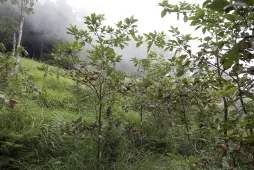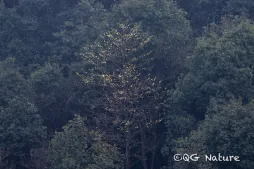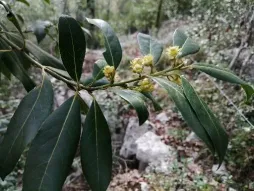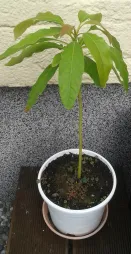Sassafras albidum, Iroquois laurel
Iroquois laurel, in Latin Sassafras albidum, grows in the forests of eastern Canada and the United States. A true chameleon, this tree of the Lauraceae family changes color with the seasons.
How to recognize Sassafras albidum, the Iroquois laurel?
Smaller than sassafras tzumu, Sassafras albidum reaches 25 meters in height in its natural habitat. In other latitudes, its growth is more modest. In its early years, this deciduous tree has a dense, spreading habit. Later, it adopts a pyramidal shape.
The trunk measures up to 60 centimetres in diameter. Its dark-brown bark is deeply furrowed.
The fragrant foliage gives off a lemony scent when crumpled. Several different leaf shapes can be found on the same tree and branch. Blades may be two-lobed, three-lobed or entire. They measure up to sixteen centimetres long and ten centimetres wide. Young shoots are greenish-yellow. They turn reddish-brown before turning yellow and golden in autumn.
In spring, before the foliage appears, yellow or greenish flowers bloom.
Female flowers give rise to dark-blue drupes containing a single seed.
Sassafras albidum is non-toxic to humans and animals. However, although it is used by Amerindians to make tea, the bark contains safrole, a chemical compound that proves harmful when consumed in large quantities.
Our maintenance tips
Watering
Water the base of your sassafras albidum when the soil is about three centimeters dry. Your plant likes rainwater, but will also tolerate mains water.
Don't let water stagnate in the planter or saucer. It will rot the roots.
Repotting
Soak the root ball of your Iroquois Laurel to rehydrate it. Shake the plant to remove excess water.
Get a pierced terracotta pot. You can make a bed of clay balls at the bottom to improve drainage. Mix at least 25% heather soil with ordinary potting compost. Pour on a layer of substrate and plant your Iroquois Laurel.
Water generously to remove air bubbles and encourage rooting.
Fertilization
Apply a dose of compost at the foot of the plant.
Prune
To encourage the growth of your Iroquois Laurel, prune regularly.
Remove the suckers that form at the foot of your Iroquois Laurel if you want your tree to retain a single trunk and not multiply.
Remove dead branches at the base using clean, sharp pruning shears.
You can also remove any suckers growing on the trunk.
Plantation
Soak your Iroquois Laurel while digging a hole twice the size of the root ball. Place a handful of organic fertilizer at the bottom.
Then install your Iroquois Laurel. Make sure that the top of the rootball is two to three centimetres below the surface of the soil. Fill the hole with garden soil and tamp to remove air bubbles.
Water for the first time to help the plant take root.
Cutting
Cutting is carried out during the strong growth phase, generally in spring and early summer.
Using your hands or a clean, sharp tool, separate one of the shoots that has formed at the base of the plant. Choose a young shoot with roots.
Pour universal potting soil into a perforated pot. Use your finger or pen to make a hole. Plant your Sassafras albidum. Water generously to encourage rooting and place the cutting in partial shade.
Information
| Family | Lauraceae - Lauraceae |
| Type | Sassafras - Sassafras |
| Species | Iroquois Laurel - Sassafras albidum |
| Lifecycle | Perennial |
| Foliage | Deciduous |
| Exposures | |
| Substrats | |
| Planting methods |
Open ground In pots |
| Category | |
| Tags |
Beginner Rustic |
| Origin |
North America |
| Hardiness (USDA) | 5b |
| Leaf color |
|
| Flower color |
|
| Fruit color |
|
Discover plants from the same family





















